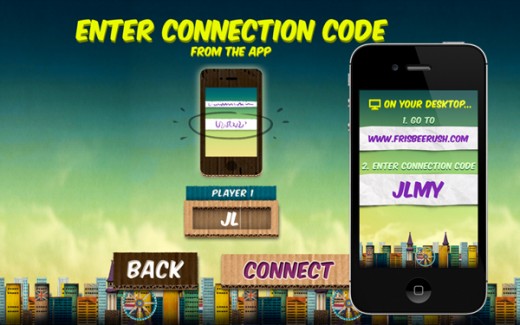
We don’t cover a lot of game apps here on The Next Web, as we noted last week in our best Android apps of 2012 piece. The few that we do cover generally have some form of mass appeal, or otherwise possess a standout feature that means we really can’t ignore them.
Frisbee Rush is one such app, available for Android and iOS devices. Your mission is to stop an alien invasion by flicking Frisbees using your smartphone as a controller, directing the unlikely missiles at the browser on your computer.
The game is currently classified as “experimental”, but my initial tinkerings – using a Samsung Galaxy S2 and Firefox on my laptop, revealed what was a fully functional, almost flawless product.
How it works
First up, you must download the controller to your phone (Android | iOS), then head to the Frisbee Rush website. When you click on ‘Play Now’, you’ll be invited to install the Unity player for your browser. You’ll also have to launch the app on your phone, and then enter the connection code from your mobile device into the browser.

Whilst you can go it alone, you can also battle it out with friends as it allows up to three players to connect with the game.
Whilst it’s recommended that your mobile be connected to the Web through WiFi, I actually missed that instruction until after I played the game. But the good news is that my device seemed to cope just fine using 3G, and it interacted seamlessly with the browser.
Now, there are two possible controls – ‘Flick Screen’, where you define the altitude of shot by tilting the device up or down. And then there’s ‘Swing Device’, where you perform a throw gesture whilst you hold your phone tight. Here’s a full demo of the game being played to give you a better idea:
http://www.youtube.com/watch?v=4blV2lG3e8E
The app was developed using Adobe AIR with Flash, which provided enough flexibility on the app’s distribution by using the same source for different platforms. The app then connects seamlessly to the Unity Game through an HTML5 WebSocket.
“Creating the game environment in Unity allowed us to introduce mesh slicing to all the 3D buildings in the city, meaning that the player has complete freedom to slice any building, at any point, at any angle,” say the developers at Unit9.
This isn’t the first time we’ve covered such a game. Back in March, we got wind of a cool little demo game that lets users tap the power of their iOS devices to use it as a controller for a game on a desktop browser too.
A product of London-based Web development company WebDigi, Spaceship Pilot is an unremarkable game in its own right – it’s basically just Space Invaders. But it helped demonstrate the latent potential of HTML 5 gaming when used in conjunction with the tech contained within modern smartphone devices.
The accelerometer support within Mobile Safari enables the browser to sense movement, speed and direction with Javascript on iOS devices. This movement data is channeled from the iOS device directly through a node.js server to the browser.
It’s clear we’ll start seeing greater use of such technology moving forward, and an HTML 5 gaming control pad is another one for a smartphone’s list of functions in addition to making telephone calls. As we reported last week, phone calls are now only the fifth most frequent smartphone activity in the UK.
Get the TNW newsletter
Get the most important tech news in your inbox each week.





